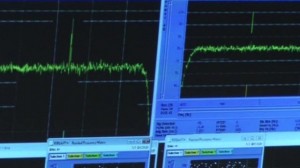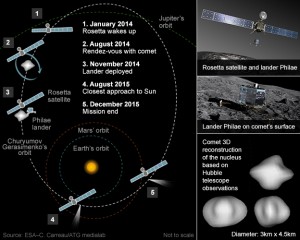Great is the Lord and most worthy of praise; (Psalm 145):
Posted by SociusJan 23
The heading above may seem a little strange for this blog, for, first of all I want to talk a little about man’s recent successes with the ‘Rosetta Space Probe’. Just a few days ago, it was announced on the news that scientists at the Control Room in Germany had sent a ‘wake up’ signal to the probe, in an attempt to bring it out of its 31 months’ hibernation. Rosetta had been put into a deep sleep, in June 2011, to allow it to conserve power, in readiness for its August 2014 meeting, in space, with a comet – the Comet 67P/Churyumov-Gerasimenko. Would the signal bring ‘Rosetta’ out of its reverie? Everyone waited with baited breath, then 45 minutes later, Rosetta signalled it was awake.
 |
Delight in the control room as Rosetta sends back a signal confirming it is “awake”
Launched from earth in 2004, ‘Rosetta’ has been speeding at mind-boggling speeds outwards and towards this small comet, which is measured at only 4.5 kilometres wide. The comet’s orbit around the solar system describes a very large ellipse, so that at times it has been at maximum separation – millions of miles from the sun. In August of this year, its orbit will be at minimum distance, and so the planning is that, at that time, ‘Rosetta’ will rendezvous with Comet 67/P, and in November, 2014, it will attempt to land a small Philae lander on the surface of the comet.
 |
When things begin to happen in a few months time, it will be a time-consuming and very complicated process, as commands between the controllers and the probe will take 45 minutes to travel one way – an indication of the huge distances involved. From March until the end of April, the instruments will be switched on, one by one – all of them will have to be checked, and, in some instances, their controlling soft-ware will have to be updated.
Beginning in May, this year, the probe will start to fire her thrusters, so that it may then target Comet 67/P – but again the distances between the two – probe and comet – will be varying enormously. Today the separation is as much as nine million kilometres, whereas in November, when the Philae lander will be deployed, the distance will be as small as 10 kilometres.
The probe has made a very circuitous route to its target – having passed through the orbits of several planets on its ways. In doing so it has been constructed to pick up energy from those orbits to help it on its way and to enable it to complete its mission. In its journey it has passed by the ‘Steins’ rocks (2008) and ‘Lutetia’ (2010), sending back a great deal of information about these space bodies – and their origins – in so doing.
Eventually, it is hoped that Rosetta will follow the comet as it moves closer to the sun; if successful, it will be transmitting information on changes that take place in the body of that comet, whereas the Philae lander will report any changes taking place on the surface. Comets are thought to contain materials largely unchanged since the solar system was formed 4.6 billion years ago. Samples of the chemical and physical composition of the comet should enable scientists to begin studying changes that have taken place over time, and, ultimately, how, when and where, the comet was formed; they will also tell of its journey through time as the Solar system has developed and about our Sun itself.
Rosetta is being billed as the big space event of 2014. The Director of ESA’s Human Spaceflight and Operations, Thomas Reiter, made the following comments:
“Science, in general, catches the public’s imagination. In general, we try to find answers to fundamental questions, such as where do we come from, what will be our destiny and will we have to stick to this planet?
“The knowledge we get from missions like Rosetta – which is now moving into a very interesting stage – gets us closer to answering those types of questions.”
~~~~~~~~~~~~~~~~~~
In my book, all this is very interesting, but it also raises a number of very important questions, mentioned, in passing, by Mr Reiter. I am left stupefied by the time-distances involved, by the enormity of space, of the stars and their life-spans – never mind what actually happens when one finally implodes and disappears for ever. I am left mind-boggled by our galaxy and all that it involves – never mind how many other galaxies there are, and this we do not know. And limitless space – how big is that? I am left ‘floored’ by the question of just how great all this must be – how complex – how ordered – how sustained, and by questions as to how this came to be and, what will happen to all temporal life, come the end of the world?
At lunch with a friend the other week, we got to discussing space exploration and the problem of under-developed countries. India came to mind, and we talked about the ethics of sending rockets into space (and the costs which must be counted in billions), when millions of the ordinary population are starving. My friend then posed the question as to whether there are other planets on which beings, like ourselves, live and survive. He suggested that it may be possible that such other beings could be far more advanced than we humans, and, using their much greater technologies, they could, at some time, decide to visit us. When they came, what would their reaction be, and would they view us as animals and potential food?
The third important question asks whether space exploration is of any great benefit to the ‘ordinary man in the street’. Could not these vast sums of money be better spent on looking after the poor, the sick and disadvantaged? These are big questions, important questions, and, in many cases, there are just no solutions.
The acceptance of all the multi-advances that have taken place in science and technology, over centuries – accelerated greatly, it must be said, in recent decades – ends in a double-edged judgement: on the one hand, they have brought many, many improvements to our way of life: on the other, many would agree, that not all results have been positive as regards their final ‘cost-benefit’ analysis. In many cases, perhaps, it has been a case of ‘one step forward – two steps back’!
Many great minds have gone though life, wondering, and searching for answers to the great mysteries – the great unknowns – that concern Rodin’s ‘thinkers’ and many ordinary people who concern themselves with life and the environment in which we exist. But, in all truth, we must then turn our attention in quite another direction and say, really, there is no need for us to worry. God has all this in hand – and has had since before time began. Moreover, He has promised to be with us always. All life is constantly changing, and in many instances, we have little or no control over the changes that come about.
What does not change – and He is eternal – is God. His name, in the Bible, is often given as ‘I AM’, meaning that He was always in existence, the power over all. There never was a time when God was not there – something we cannot understand, since our reasoning is finite (and fallible). All the wonders of space – all those that science and exploration are now revealing – have been there for eons – long before humanity – long before life in all its many forms, but they are as yesterday-born compared with God and his timelessness. He is the first cause, the first mover; it is He who controls; it is He who designs; it is He who sustains it all in being; it is He who is first and last.
Many, I know, will say, the existence of God cannot be proved, and I have heard it said of some, that to those who refuse to believe, no proof is possible. To those who believe, however, no proof is necessary. Faith is a great gift of the Spirit of God – and what would we do, those of us who believe, without it?
Certainly, I believe, the world would be a much poorer place. As the title for the blog proclaims:
“Great is the Lord and most worthy of praise.”
Socius

No comments